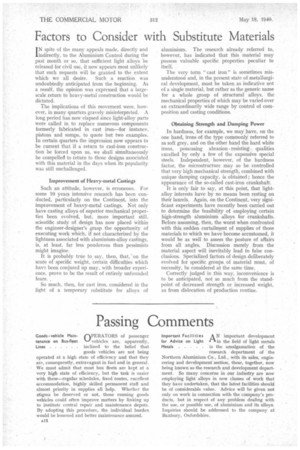Factors to Consider with Substitute Materials
Page 14

If you've noticed an error in this article please click here to report it so we can fix it.
I N spite of the many appeals made, directly and indirectly, to the Aluminium Control during the past month or so, that sufficient light alloys be released for civil use, it now appears most unlikely that such requests will be granted to the extent which we all desire. Such a reaction was undoubtedly anticipated from the beginning. As a result, the opinion was expressed that a largescale return to heavy-metal construction would be dictated.
The implications of this movement were, however, in many quarters gravely misinterpreted. A long period has now elapsed since light-alloy parts were called in to replace numerous components formerly fabricated in east iron—for instance. pistons and sumps, to quote but two examples. In certain quarters the impression now appears to be current that if a return to cast-iron construction be forced upon us, we shall simultaneously be compelled to return to those designs associated with this material in the days when its popularity was still unchallenged.
Improvement of Heavy-metal Castings Such an attitude, however, is erroneous. For some 10 years intensive research has been conducted, particularly, on the Continent, into the improvement of heavy-metal castings. Not only have casting alloys of superior mechanical properties been evolved, but, more important still, scientific study of design has now placed within the engineer-designer's grasp the opportunity of executing work which, if not characterized by the lightness associated with aluminium-alloy castings, is, at least, far less ponderous than pessimists might imagine.
It is probably true to say, then, that, on the score of specific weight, certain difficulties which have been conjured up may, with broader experience, prove to be the result of entirely unfounded fears. .
So much, then, for cast iron, considered in the light of a temporary substitute for alloys of aluininium. The research already referred to, however, has indicated that this material may possess valuable specific properties peculiar to itself.
The very term "cast iron" is sometimes misunderstood and, in the present state of metallurgical development, must be taken as indicative not of a single material, but rather as the generic name for a whole group of structural alloys, the mechanical properties of which may be varied over an extraordinarily wide range by control of composition and casting conditions.
Obtaining Strength and Damping Power In hardness, for example, we may have, on the one hand, irons of the type commonly referred to as soft grey, and on the other hand the hard white irons, possessing abrasion resisting qualities excelled by only a few of the expensive special steels. Independent, however, of the hardness factor, the microstructure may so be controlled that very high mechanical strength, combined with unique damping capacity, is obtained ; hence the appearance of the so-called cast-iron crankshaft.
• It is only fair to say, at this point, that lightalloy interests have by no means been resting on their laurels. Again, on the Continent, very significant experiments have recently been carried out to determine the feasibility of employing certain high-strength aluminium alloys for crankshafts. Before assuming, then, the worst when confronted with this sudden curtailment of supplies of those materials to which we have become accustomed, it would be as well to assess the posture of affairs from all angles. Discussion merely from the material aspect will inevitably lead to false conclusions. Specialized factors of design deliberately evolved for specific groups of material must, of necessity, be considered at the same time.
Correctly judged in this way, inconvenience is to be anticipated, not so much from the standpoint of decreased strength or increased weight, as from dislocation of production routine.




















































